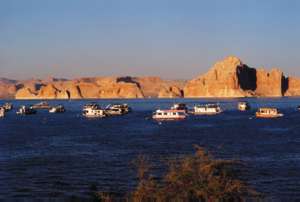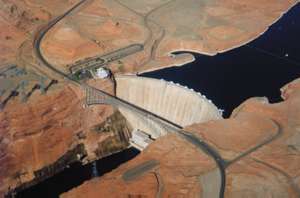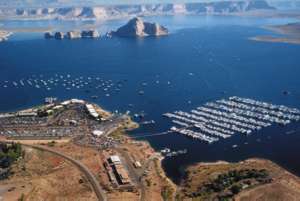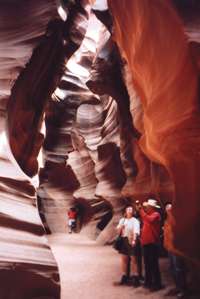|
|
 |
| SW Aviator Magazine is available in print free at FBOs and aviation-related businesses throughout the Southwest or by subscription. |

|
 |

|
 |
 |
 |
|
The web's most comprehensive database of Southwest area aviation events.
|

|
 |

|
 |
|
Featured Site:
|
|
|
 |
|
A continuosly changing collection of links to our favorite aviation related web sites.
|

|
 |

|
 |
 |
|

|
Lake Powell
|
|
Page, AZ
|

Story by Gerrit Paulsen
Photos by Cindy and Gerrit Paulsen
Flying over Lake Powell is a memorable experience. The stark contrast of blue water against bleached red sandstone, the enormous buttes rising like medieval castles from their moat, and the countless twisting side canyons bringing cool fingers of water deep into the harsh, beautiful desert are unique awe-inspiring sights. However, the lake is not just for aerial sightseeing; boat tours, river rafting, and spectacular slot canyons all await those who take the time to linger on the shores of Lake Powell.
Lake Powell starts in northern Arizona and extends northeastwards deep into southern Utah. It is part of the Colorado River in Glen Canyon National Recreation Area. The only town in the Lake Powell area is Page, Arizona, at the southern end of lake. Page began as a construction camp over 40 years ago for the giant hydroelectric project building Glen Canyon Dam. Today, Page is a thriving city of more than 8,200 people, with the best “backyard” any recreationist could want – Lake Powell. Though the Glen Canyon Dam was completed in 1962, the lake did not completely fill until 1980. Currently, the lake is down 95 feet from full pool, due to the extended drought and high water demand here in the Southwest.
Lake Powell – which drowned most of Glen Canyon – is named, ironically, after the man who had first written of the canyon’s many charms. In 1869, John Wesley Powell and his men were the first people to fully explore the canyons of the Colorado River, and named many features, including Glen Canyon. In the decades after Powell’s visits, few people ventured into this inhospitable canyon, so it remained a place largely unknown, even in the early 1950s, when the Bureau of Reclamation proposed building a dam at Glen Canyon’s southern end.
The nation’s environmental movement, still in its infancy at the time, was also unaware of wonders of Glen Canyon. Its secret beauty remained undiscovered by those who might have preserved it until after the dam was built, and the impending flood was irreversible. The loss of this unique wilderness sparked a controversy that contributed to the birth to the modern-day environmental movement, and began a debate that continues today on the value of the lake versus the ecological damage it caused.

Today, Glen Canyon National Recreation Area and Lake Powell serve the needs of a diverse population. The lake offers opportunities for a variety of water-based recreational pursuits. The dam provides water storage for irrigation, produces electricity for millions, and — thankfully — is currently serving its indented role as a reliable water source during times of extreme drought. The lake also enables easy access by boat to the backcountry above water level, which is still as vast, remote, and astonishingly beautiful as it was before the dam.
By all means, spend time flight-seeing Lake Powell and its surroundings. Be sure to budget plenty of time and fuel though; this lake is BIG. It is 186 miles long, with almost 2,000 miles of shoreline. There are 96 major canyons (think of them as fingers of the lake), some of which are 15 to 20 miles in length. The southern half of the lake has monumental scenery, with massive buttes and spires rising from the water. The area west and south of Navajo Mountain, near the center of the lake, is also particularly scenic. At its base lies Rainbow Bridge (N37 04.54, W 110 57.66), a massive natural sandstone arch surrounded by a jumble of watery canyons. (Keep an eye out for air-tour operators here; it can get quite busy at times.) The landscape south of Navajo Mountain is a fine example of how this area looked before it was flooded.
Further north, the lake splits at the now drowned confluence of the Colorado and San Juan Rivers. Following the meanders of the San Juan River canyon to the east will eventually take you to the impressive Goosenecks of the San Juan, just past the end of the lake. Continuing north along the old Colorado riverbed, look for the remnants of the Hole-in-the-Rock trail, just north of the confluence. This is the hard-won passage that Mormon pioneers carved through this seemingly impenetrable landscape. Further upstream you will find the marinas and airports serving the north end of the lake. Fuel is available at Cal Black (U96), where you can also catch a ride down to the Halls Crossing marina. The unattended Bullfrog airstrip (U07) is just across the lake, providing convenient access to the Bullfrog Marina and the Defiance House Lodge and restaurant. Call the Bullfrog Marina on Unicom before you land to dispatch the courtesy shuttle.
As with all National Recreation Areas, the sectional chart displays the airspace over and around Lake Powell as an area where 2000-foot AGL minimum overflight is requested. While I am normally happy to comply with this request over National Parks and Wilderness Areas, I find it rather hypocritical here, where the constant din of powerboats, jet skis, and rumbling houseboat power generators echoing against the canyon walls below drowns out the sound of our little airplane.
Upon your return to Page, be sure to flight-see the Colorado River south of Glen Canyon Dam as well. Watch for the unmistakable Horseshoe Bend in the river, and for the boat launch area at Lee’s Ferry. This is the terminus for float trips from Page, and the starting point for Grand Canyon river rafting expeditions. Consider landing at the Marble Canyon airstrip, where you can park directly across the street from a nice restaurant and trading post.

After a long day of flying and sightseeing, you’ll want a comfortable hotel. Our favorite place to stay in Page is the Wahweap Lodge, right on the shore of Lake Powell (800-528-6154, visitlakepowell.com). This is the only hotel on the lake (with the exception of the Defiance House Lodge at Bullfrog, over 100 miles to the north). The rooms are spacious and well equipped, including refrigerators and coffee makers, and all have balconies or patios to enjoy the view. Prices start around $100 in the off-season (November through March), and rise by roughly $50 in the high season (April through October). Be sure to get a room facing the lake, it’s only $10 more for the fabulous view. The Lodge’s Rainbow Room dining room serves breakfast, lunch, and dinner, with an unsurpassed view of the stunning lake scenery. Wahweap has a free courtesy shuttle to and from the airport, just ask the FBO at the airport to call them when you land. A $3 per person fee is required when entering the Recreation Area (good for up to seven days), or if you rent a car, the fee is $10 per vehicle.
There are many other good motels and restaurants in the town of Page. For more information, contact the John Wesley Powell Memorial Museum and Visitor Information Center (888-JWP-MUSEUM, powellmuseum.org). The Museum’s Visitor Information Center serves as a referral service for accommodations offered by local motel/hotel/bed and breakfast establishments. You do not pay extra for this service, and the museum’s non-profit history center benefits by receiving a commission from the tour and rental companies. They can also assist you in booking river and lake trips, ground tours, as well as powerboat and houseboat rentals.
Within the John Wesley Powell Memorial Museum you can see sketches, photos, and other memorabilia of Powell’s epic Colorado River voyages in 1869 and 1871. There is also a unique collection of other exhibits focused on the geology of the canyons cut by the Colorado, along with displays on the history and development of Page.

Another excellent source of information on the area is the Carl Hayden Visitor Center. Located at the Glen Canyon Dam along Highway 89, it contains photos and history of the construction of Glen Canyon Dam, a three-dimensional map of Glen Canyon NRA, and other exhibits. The center is worth a stop just for the breathtaking panorama from its picture window overlooking the dam, lake, and spectacular scenery beyond. This was also the starting point for dam tours, which currently have been suspended due to the national paranoia paralyzing our country since 9/11. For more information on Glen Canyon National Recreation Area call 928-608-6200 or visit nps.gov/glca.
Next to an airplane, the best way to enjoy and explore Lake Powell is by boat. The lake is considered America’s favorite houseboating destination, and a wide variety of houseboat rentals are available at Wahweap and Bullfrog. Power and speedboat rentals are also available, as are all sorts of water toys. There are some very enticing houseboat specials currently listed on the visitlakepowell.com web site, including substantial discounts, half price powerboat rentals, and a $200 fuel allowance.
If you’d rather leave the boat driving to a professional, there are several full and half-day lake tours depart from the Wahweap Marina daily. Most popular are the trips to Rainbow Bridge, and the Wahweap Bay Cruise and Dinner Cruise on the Canyon King paddlewheeler. You could also fly up to Bullfrog for the day and catch one of their tours; either to Rainbow Bridge, or the Captain’s Choice cruise of intriguing destinations.
Float Trips down the Colorado River from Page are also very popular. This 15-mile calm water trip explores some of the last remaining untamed sections of the Colorado River, gliding beneath the towering sandstone cliffs in comfortable neoprene J-boats. The trip ends downstream at historic Lees Ferry. Prices vary around $60 per person, depending on the meals and amenities offered.

One of the most spectacular — yet little known — attractions of the Lake Powell area is located on Navajo Tribal land just a few miles east of Page. Antelope Canyon is a fantastic quarter mile long slot canyon winding through the soft sandstone. This amazing canyon has become a favorite destination for professional photographers and moviemakers since its discovery in 1931 by a young Navajo girl herding sheep through the area. The beauty of this canyon only hints at the spectacular canyons now flooded and lost forever under the waters of Lake Powell.
You can only visit Antelope Canyon with a guide authorized by the Navajo Nation. Several authorized tour companies operate out of Page. All use 4-wheel drive vehicles — necessary to negotiate the broad sandy wash that doubles as the “road” accessing the canyon — ranging from luxurious SUVs to “monster trucks” with passenger seating in the open bed. Most companies will pick you up at your hotel for the 2-hour trip. Rates are around $20 per person for the tour, plus tax and a $6 Navajo Tribal permit fee. The Powell Museum Visitors Center has a list of all the tour operator. Departure times vary with the season, and of course, are subject to weather conditions.
Fall is the perfect time of year to visit Lake Powell, with mild temperatures and calm, clear weather. Summers are extremely hot, though afternoon thunderstorms often make for cool, pleasant evenings. Winters are moderately cold, with nighttime lows frequently falling below freezing. Spring weather is highly variable, with extended windy periods. Precipitation is generally nonexistent (less than 6 inches annually), though heavy rains and flash flooding are a threat in spring and summer. There is no shade, so bring a hat and sunscreen, and carry extra water in your airplane, just in case.
Whether you visit for a weeklong houseboat adventure, or are simply flying through on your way to another, perhaps less exotic destination, flying Lake Powell is a worthwhile detour. |
Click here to return to the beginning of this article.  |
|